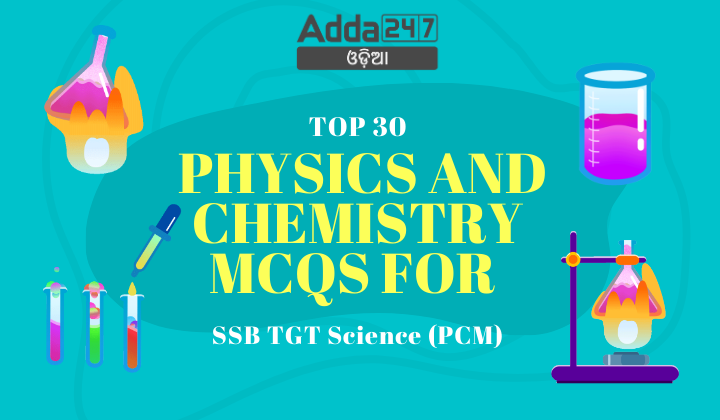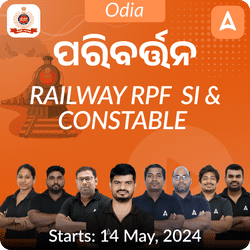The “Top 30 Physics and Chemistry MCQs” for SSB TGT Science (PCM) are essential for candidates aiming to excel in the recruitment exam. These questions encompass core topics such as mechanics, thermodynamics, electromagnetism, atomic structure, chemical bonding, and thermodynamics. Practicing these MCQs helps candidates reinforce their understanding of fundamental concepts, improve problem-solving skills, and familiarize themselves with the exam pattern. Focused preparation using these targeted questions ensures that candidates are well-equipped to tackle the science section with confidence, ultimately enhancing their chances of success in the TGT Science (PCM) examination.
Top 30 Physics and Chemistry MCQs for SSB TGT Science(PCM)
- Which element is used as a filament in light bulbs?
[A] Copper
[B] Aluminum
[C] Tungsten
[D] Iron
Correct Answer: C [Tungsten]
Notes: Tungsten is used as a filament in light bulbs because of its high melting point and good electrical conductivity. - Which gas is known as laughing gas?
[A] Nitrogen
[B] Nitrous oxide
[C] Carbon dioxide
[D] Helium
Correct Answer: B [Nitrous oxide]
Notes: Nitrous oxide (N₂O) is commonly known as laughing gas and is used for its anesthetic and analgesic effects. - Which vitamin is also known as ascorbic acid?
[A] Vitamin A
[B] Vitamin B
[C] Vitamin C
[D] Vitamin D
Correct Answer: C [Vitamin C]
Notes: Vitamin C, also known as ascorbic acid, is essential for the growth, development, and repair of body tissues. - Which of the following is a noble gas?
[A] Hydrogen
[B] Oxygen
[C] Neon
[D] Nitrogen
Correct Answer: C [Neon]
Notes: Neon is a noble gas, known for its inertness and is used in neon signs. - Which element is commonly used in batteries?
[A] Sodium
[B] Potassium
[C] Lithium
[D] Magnesium
Correct Answer: C [Lithium]
Notes: Lithium is commonly used in rechargeable batteries, including those in mobile phones and electric vehicles. - Which process is used for the purification of water?
[A] Distillation
[B] Condensation
[C] Fermentation
[D] Evaporation
Correct Answer: A [Distillation]
Notes: Distillation is a method used to purify water by boiling it and then condensing the steam back into a liquid. - Which compound is commonly known as table salt?
[A] Sodium chloride
[B] Potassium chloride
[C] Calcium chloride
[D] Magnesium chloride
Correct Answer: A [Sodium chloride]
Notes: Sodium chloride (NaCl) is the chemical name for table salt. - Which acid is found in vinegar?
[A] Citric acid
[B] Lactic acid
[C] Acetic acid
[D] Tartaric acid
Correct Answer: C [Acetic acid]
Notes: Acetic acid (CH₃COOH) is the main component of vinegar, apart from water. - Which of the following is a greenhouse gas?
[A] Oxygen
[B] Nitrogen
[C] Methane
[D] Argon
Correct Answer: C [Methane]
Notes: Methane (CH₄) is a potent greenhouse gas, contributing to global warming. - Which metal is liquid at room temperature?
[A] Gold
[B] Silver
[C] Mercury
[D] Copper
Correct Answer: C [Mercury]
Notes: Mercury is the only metal that is liquid at room temperature. - Which compound is used in the making of fertilizers?
[A] Sodium bicarbonate
[B] Ammonium nitrate
[C] Calcium carbonate
[D] Magnesium sulfate
Correct Answer: B [Ammonium nitrate]
Notes: Ammonium nitrate is widely used in fertilizers due to its high nitrogen content. - Which of the following is used to make bulletproof glass?
[A] Polycarbonate
[B] Polystyrene
[C] Polyethylene
[D] Polypropylene
Correct Answer: A [Polycarbonate]
Notes: Polycarbonate is a strong, transparent plastic used in bulletproof glass and other high-impact applications. - Which is the most abundant gas in the Earth’s atmosphere?
[A] Oxygen
[B] Carbon dioxide
[C] Nitrogen
[D] Argon
Correct Answer: C [Nitrogen]
Notes: Nitrogen makes up about 78% of the Earth’s atmosphere. - Which element is essential for the production of thyroid hormones?
[A] Iron
[B] Iodine
[C] Calcium
[D] Phosphorus
Correct Answer: B [Iodine]
Notes: Iodine is crucial for the synthesis of thyroid hormones, which regulate metabolism. - Which polymer is used to make non-stick cookware coatings?
[A] Polystyrene
[B] Polypropylene
[C] Polytetrafluoroethylene (PTFE)
[D] Polyvinyl chloride (PVC)
Correct Answer: C [Polytetrafluoroethylene (PTFE)]
Notes: PTFE, also known as Teflon, is used to coat non-stick cookware due to its high heat resistance and low friction. - Which pair of elements represents the most and least electronegative elements in the periodic table?
A) Fluorine and Hydrogen
B) Caesium and Helium
C) Chlorine and Carbon
D) Fluorine and Caesium
Answer: D
Notes: Fluorine is the most electronegative element, while Caesium is the least electronegative. - Who discovered Radium?
A) Marie and Pierre Curie
B) Andre-Louis Debierne
C) Kasimir Fajans
D) Oswald Helmuth Gohring
Answer: A
Notes: Marie and Pierre Curie discovered Radium in 1898. - Which of the following represents a chemical change?
A) Rusting of iron
B) Magnetisation of iron
C) Melting of iron
D) Heating of iron
Answer: A
Notes: Rusting of iron involves a chemical reaction and is considered a chemical change. - What is the common name of the analgesic and antipyretic drug acetylsalicylic acid?
A) Paracetamol
B) Aspirin
C) Wintergreen
D) Trazodone
Answer: B
Notes: Acetylsalicylic acid is commonly known as Aspirin. - Which metal is commonly alloyed with pure gold to make gold ornaments?
A) Silver
B) Copper
C) Zinc
D) All of the above
Answer: D
Notes: Gold is commonly alloyed with metals like silver, copper, or zinc to make it harder for use in ornaments. - Which metal is the main constituent in Pewter alloy?
A) Lead
B) Zinc
C) Tin
D) Iron
Answer: C
Notes: Pewter alloy primarily consists of tin. - What is the shape of an SF4 molecule?
A) Bent
B) See-saw
C) Trigonal Pyramidal
D) T-shape
Answer: B
Notes: SF4 molecule adopts a see-saw shape. - Which statement about the Photoelectric effect is correct?
A) The number of electrons ejected is twice the wavenumber of radiation.
B) The number of electrons ejected is proportional to the intensity of light.
C) The number of electrons ejected is proportional to the duration of light.
D) The number of electrons ejected is not dependent on the intensity of light.
Answer: B
Notes: The Photoelectric effect states that the number of ejected electrons is proportional to the intensity of light. - Which of the following represents a correct Ore-Metal pair?
A) Greenocite – Cadmium
B) Ruby Silver – Lead
C) Silestine – Copper
D) Salt peter – Magnesium
Answer: A
Notes: Greenocite is an ore of Cadmium. - What is the number of neutrons in an atom with atomic number 35 and mass number 80?
A) 35
B) 45
C) 55
D) 80
Answer: B
Notes: Number of neutrons = Mass number – Atomic number = 80 – 35 = 45. - Which element is the least electronegative in the periodic table?
A) Helium
B) Caesium
C) Carbon
D) Oxygen
Answer: B
Notes: Caesium is the least electronegative element. - What is the chemical name of the analgesic commonly known as Aspirin?
A) Acetaminophen
B) Salicylic acid
C) Paracetamol
D) Acetylsalicylic acid
Answer: D
Notes: Aspirin is the common name for acetylsalicylic acid. - Which process represents a chemical change?
A) Rusting of iron
B) Melting of ice
C) Dissolving sugar in water
D) Boiling water
Answer: A
Notes: Rusting of iron involves a chemical reaction. - What is the term for the minimum speed required to place a satellite into a specific orbit around the Earth?
A) Escape velocity
B) Orbital velocity
C) Terminal velocity
D) Rotational speed
Answer: B
Notes: Orbital velocity is the minimum speed required to put a satellite into a given orbit around the Earth - Which body does not exhibit any tendency to recover its original shape after the removal of a deforming force?
A) Perfectly elastic
B) Perfectly plastic
C) Perfectly ductile
D) Perfectly malleable
Answer: B
Notes: A perfectly plastic body has no tendency to recover its original configuration once the deforming force is removed. Examples include paraffin wax and wet clay.










